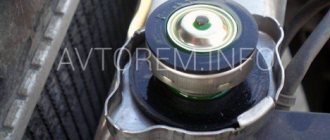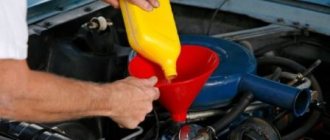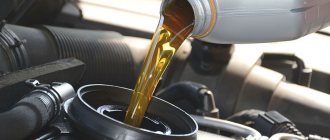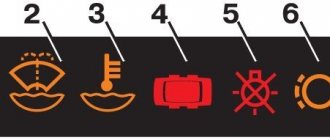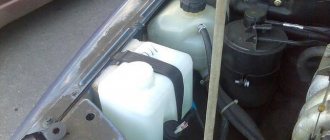One of the common problems that arise with the engine cooling system is a fluid leak. Due to low levels of antifreeze, problems may occur with both the engine itself and parts of the cooling system. Therefore, the fluid level in the expansion tank must be regularly monitored and not allowed to drop below MIN. You can determine that antifreeze is running out by the following signs:
- The coolant level is constantly decreasing;
- the heater stops working;
- The engine temperature becomes higher than normal.
A minimal increase or decrease in the coolant level in the expansion tank is considered normal. However, if antifreeze needs to be topped up periodically, then you need to deal with the problem that has arisen.
Engine radiator leaking
The most common reason why coolant leaves the system is damage to the main radiator of the cooling system. The malfunction can be diagnosed by smudges on the unit body or a puddle under the car after parking. Damage to the heat exchanger can be caused by the following factors:
- exposure to corrosion as a result of long-term use;
- hit by a stone flying out from under the wheels.
The design of the radiator consists of many honeycombs through which coolant circulates. Even the slightest damage to one of them will lead to leakage. To diagnose a breakdown, you will need to remove the heat exchanger from the car, assess the nature of the damage and try to restore the seal by soldering or argon welding. If you do not take any action to eliminate the leak, the engine will overheat, which sooner or later will lead to serious consequences and expensive repairs.
Malfunction of the radiator or heater tap
Sometimes there is a leak in the interior heater core. The problem manifests itself as a puddle of coolant under the front passenger's carpet, as well as a foggy windshield. In this case, the radiator will have to be removed from the car to identify the damaged area and carry out similar measures as with the main radiator.
Depending on the make and model of the vehicle, removing the heat exchanger may require disassembling the instrument panel.
If the leak is caused by a leak in the faucet, drops of antifreeze will be visible on it. The device, as a rule, cannot be repaired and must be replaced with a new part. Sometimes antifreeze begins to leak due to aging of the gaskets between the faucet and the radiator. In this case, they are simply replaced with new ones.
Defects in hoses, pipes and pipes
A large number of pipes made of rubber are used as connecting elements in the engine cooling system. Due to constant exposure to an aggressive environment, temperature changes and vibrations, rubber becomes unusable over time and cracks appear. The formation of damage to the pipes clearly leads to a leak of antifreeze as the engine warms up and the pressure in the system increases. Worn hoses must only be replaced. Any tricks and attempts to patch and restore their integrity will lead to leakage and loss of antifreeze. If the malfunction can be eliminated, it will only be for a short time.
The tightness can be compromised not only by damage or wear of rubber pipes, but also by metal tubes, which are also present in the cooling system. These elements corrode and burst over time. Therefore, if a leak is detected, the tubes must be replaced.
Pump failure
Sometimes the reason for coolant leakage is wear of the water pump seals: gasket and oil seal. The gasket most often fails due to long life or as a result of damage, for example, if the pump was over-tightened. Confirmation of pump leakage is a wet engine where the pump is installed, as well as the presence of drops of coolant on the mechanism housing from below. If the malfunction is caused by wear of the gasket, then it is enough to replace it or use a sealant gasket. If the oil seal fails, repairs will have to be made if the pump design allows this. Otherwise, the unit must be replaced.
Thermostat
As a result of prolonged use, the thermostat housing begins to leak over time. This unit is responsible for regulating the flow of coolant by opening and closing a valve located inside. In case of any breakdown, the device must only be replaced.
Expansion tank defects
The expansion tank body is usually made of plastic. Over time, it can either burst or rub against body elements, which depends on the installation location. Such a malfunction cannot be ignored, since the container or its lower part will be wet. If the tank is damaged, you can try to solder it, but it is better to replace it with a new one, since soldering will only temporarily eliminate the leak. In addition to the tank, the lid may fail, since a valve is mounted inside it, designed to maintain a certain pressure in the system. If there is a problem with the valve, antifreeze will splash out after the engine warms up. In this case, the cover needs to be diagnosed or replaced.
When to change coolant
Drain plug
There are several situations that will require you to carry out the procedure for replacing the coolant.
- The color of the coolant has changed. The liquid may take on a rusty color. This indicates the need for replacement.
- An oil film has formed on the surface of the cooler.
- Antifreeze often bubbles in the expansion tank of a VAZ 2110. Moreover, there were no prerequisites for such a phenomenon. The Ten is a car for good speeds, because when driving at low speeds, the antifreeze in the expansion tank on the VAZ 2110 often boils. This is because the cooling fan does not turn on.
- A coolant that is no longer suitable for further use may also boil, the composition of which has changed significantly since it was poured into the expansion tank.
- Antifreeze is leaking somewhere from the expansion tank on a VAZ 2110. The situation is common, but it cannot be solved by adding or replacing coolant. It is necessary to find where the antifreeze is leaking from the expansion tank of the VAZ 2110. Usually the leak is found on the clamps, although it would not be a bad idea to check the entire system.
- The coolant level may be normal, during operation it does not emit antifreeze from the expansion tank of the VAZ 2110, the color is normal, but still the boiling process occurs quickly. Most likely, the reason lies in the airlock.
Replacing the VAZ 2110 coolant: boils, antifreeze disappears
Every car owner should be able to correctly replace antifreeze on a VAZ 2110. Antifreeze is a coolant that cools the engine and maintains it at optimal operating temperature.
Coolant reservoir
Remove coolant from the car, and the engine will immediately begin to overheat and will not be able to function properly.
Additionally, antifreeze provides protection against corrosion, allows you to extend the life of the engine, and has a slight lubricating property.
Hidden problems
You have looked at everything and everyone, there are no leaks anywhere, all the hoses and clamps are in order, but the antifreeze or antifreeze goes away, “even if you crack”! The fact is that there are not only open leaks, but also so-called hidden ones, and they are much more dangerous.
A car engine is not a cast structure - there is a separate engine block and cylinder head. There is a gasket between these two parts, this is mandatory, it is high-temperature (can maintain high positive values), and it is also a sealing link. In the engine block, as well as in the cylinder head, there are channels through which antifreeze (antifreeze) passes, cooling the metal, thus the “entire engine” is at an operating temperature that does not exceed 90 - 100 degrees Celsius, without this fluid the engine would very quickly warmed up and it simply jammed.
So, the coolant also passes through the gasket, since it is an intermediate link (by the way, it has special channels). If the gasket is defective or poorly tightened, the tightness of the channels is broken and coolant can pass into the engine cylinders. That is, it will enter the combustion chamber, then through this chamber it will exit into the exhaust pipe, while the level of antifreeze (antifreeze) will decrease in the expansion tank.
What are the signs of such a breakdown?
- This is white and thick smoke from the exhaust pipe, it will really be like fog - we read about it here .
- The engine oil level will rise.
- The oil will be interspersed with antifreeze or antifreeze, that is, with bubbles.
- Coolant will leak out of the reservoir, and constantly.
In this case, it is 100% a gasket; we must change it. After all, sometimes antifreeze or antifreeze can get into the engine oil, and this is serious! Here the capital is just a stone's throw away.
- The oil mixes with the liquid and forms an incomprehensible “slurry”; it will begin to coagulate, which will clog all the channels - overheating of the engine is guaranteed.
- It will not be able to properly lubricate the engine cylinders, this will lead to wear of the piston rings.
- Also, this substance will clog all the channels on the crankshaft, which will also increase its wear; the liners in which it rotates can simply turn.
Bottom line - if antifreeze or antifreeze goes into the engine, driving is prohibited!
This is reason number “1”, however, antifreeze can also flow through various channels of the cooling system. They also have gaskets adjacent to the engine block and when they wear out they leak.
Tank malfunctions
Most often, it is because of the tank that coolant begins to eject, reasons:
- The seal is broken. Antifreeze has a high fluidity, which is why it can penetrate even through small cracks that are not visually noticeable. Thus, when the pressure increases, the liquid is squeezed out. Check for stains under the car after parking. It is best to completely replace the tank if there is leakage;
- Defective neck threads. When checking the expansion tank cap, pay attention to the threads of the neck and the valve itself. Cheap and low-quality products often have burrs and chips, which make a tight fit impossible. An increase in pressure provokes coolant leakage through these channels;
- Valve. The valve cover is also a common cause of fluid leaking from the reservoir. Moreover, the problem is quite easy to identify. Everything works fine at idle. But by increasing the speed, under load, the liquid is literally pushed out from under the valve. First try to disassemble and clean the element. If this does not help, the valve needs to be replaced.
Replacement procedure
Unscrew the nut
So, we got to the most important thing - replacing the antifreeze in your VAZ 2110. The process consists of several successive stages.
- Put on protective equipment - glasses for your eyes, gloves for your hands. When the engine is boiling, never touch the reservoir cap with your hands.
- Place the car on a level surface. Although if you raise the front of the car a little, this will allow you to drain more coolant.
- Remove the negative cable from the battery.
- Remove the bracket and ignition module. This will allow you to get to the cylinder block.
- Place a container under the drain plug to catch the old coolant.
- Remove the plug located on the expansion tank. This will create pressure in the system, which will allow the liquid to drain faster. Let the antifreeze drain until the liquid flow stops on its own.
- Next, place the container under the radiator, unscrew the cap and allow the liquid to drain from there. Be patient if coolant flows out slowly. The more you drain it, the better for your car.
- When the flow stops, check the condition of the pipes, plugs, and fasteners. If there are defects, damage or cracks, be sure to replace the elements.
- To prevent an air lock from forming on the injection engine, be sure to remove the hose where it connects to the fitting for heating the throttle pipe. If the engine is carburetor, a similar connection is dismantled, only this time the carburetor is heated.
- Try to measure the volume of drained antifreeze. It is the same amount of new coolant that should be poured into the system. One way or another, the CO must be completely filled with coolant. In this case, antifreeze.
- After completing the replacement procedure, close the expansion tank cap as tightly as possible. Reinstall all the hoses, install the ignition module in its mounting socket, and connect the wire to the battery.
- Only after this can the engine be started. Let it warm up a bit. During this time, the liquid level may drop. This indicates that an air plug has formed in the system, which was pushed through. Of course, leakage can also occur if you have not secured the hoses and clamps well. It's okay if the coolant level drops a little if there are no leaks. Just add the missing amount, bringing the volume of antifreeze in the tank to the optimal level.
A little about the problem
The expansion tank is an integral component of the internal combustion engine cooling system. The main task of this element is to dampen pressure fluctuations inside pipelines that arise as a result of a decrease or increase in the volume of cooling liquid when it is cooled and heated, respectively.
Such a capacity allows you to reduce mechanical loads on the entire cooling system. Thus, the internal combustion engine is protected from water hammer and air locks. Although they cannot be completely prevented, as a result, sometimes you have to figure out how to remove the airlock. Essentially, the tank replenishes the liquid deficit in the cooling lines and acts as a receiving tank when excess coolant appears, which occurs when the composition is heated. Structurally, it is a seemingly ordinary sealed plastic tank.
An integral element of the unit is the expansion tank cap, which also serves as a valve. With its help, pressure enters the tank from the outside when there is a deficiency in the system, or excess pressure is released.
When the coolant heats up, the liquid gradually expands, thereby filling the tank space. In parallel with the increase in evaporation from heating, the internal pressure increases. For various tank designs and specific car engines, along with their cooling system, certain threshold pressure values are provided. When they are reached, a valve begins to operate, which expels excess pressure from the system. But there are situations when the antifreeze is already boiling, the pressure increases, but it does not release. Instead, it throws out the liquid itself. That is, the valve does not cope with its tasks. Why this happens and how to deal with it is the key question of this material.
Moreover, emissions can appear after the engine is stopped and during operation of the power plant. Let's understand the reasons.
Since antifreeze can evaporate quickly, especially on a hot engine, this makes it difficult to identify the location of its leak . If a large amount of antifreeze leaks out, it is easier to spot the leak.
- When antifreeze leaks in the cabin, this indicates a malfunction of the stove. It needs to be changed. Faucets can also leak.
- When antifreeze enters the combustion chamber, it will cause water to appear on the exhaust pipe. The smoke will turn black . This will indicate that the gasket in the block is faulty.
- It is worth checking the tightness of the pipes. They need to be examined carefully, especially in the area of the tank. Often in a VAZ-2110 antifreeze can leak from the bottom of the tank where the pipe is attached.
All these moments can be accompanied by overheating of the engine and boiling of the liquid in the cooling system. Its temperature can usually be determined using a sensor on the instrument panel.
Consequences
If such problems with the cooling system are not corrected in a timely manner, this can lead to serious consequences. When antifreeze simply leaks out of the system, this will cause the engine to overheat and fail.
First of all, when the engine overheats, the gasket in the block will suffer. At high temperatures it can lose its properties and burn out. In this case, antifreeze will get into the oil, reducing and worsening its properties. This will affect the lubrication of parts rubbing against each other. They will quickly fail.
What to do if antifreeze gets into the cylinders
So, after determining why there was antifreeze in the engine cylinder, the question arises of how to eliminate this malfunction. The simplest solution, as you might have guessed, is to eliminate the first cause of such a leak.
We are talking about replacing the gasket, since it will be enough just to replace the gasket under the cylinder head to restore tightness. Its cost is relatively low, especially when it comes to domestic cars.
The most difficult action in this case will be removing, and borrowing and replacing the head itself. However, there is nothing overly complicated about this: you just need to have the appropriate keys and follow the sequence of unscrewing and tightening the nuts. Moreover, the cylinder head is tightened using a torque wrench in compliance with all standards for a specific car model.
By the way, if antifreeze gets into the cylinders, then you will have to remove the head in any case and do troubleshooting. In the event that there are flaws (on the plane where the gasket fits), you will have to do grinding.
In most cases, it is difficult to do without the help of a specialist. But this procedure will not help if the head has become deformed (as they say, it has “begun”) due to overheating or incorrectly tightened nuts. If so, then only replacing the head will save you from getting antifreeze into the cylinder. Well, if antifreeze gets inside because cracks have appeared in the block, then repair or replacement of the block itself will be required.
We also recommend reading the article about what to do if the cylinder block or cylinder head is cracked. From this article you will learn how to remove a crack using accessible methods.
Why coolant goes away and solution to the problem
Reasons for throwing away antifreeze
Let's look at the main reasons why antifreeze leaves the expansion tank. One of the main ones may be that the parts of the cooling system have deteriorated after prolonged use. Due to the fact that the pipes, various hoses and tubes, and gaskets are constantly exposed to high pressure when the engine is running, it is natural that they wear out and break. Therefore, the cause can be identified as depressurization of the main parts of the cooling system.
Another reason may be that sometimes even a new tank may have chips and cracks (both on the tank itself and on the lid). Because of this, their contact is loose and the antifreeze disappears from the expansion tank.
A third reason may be that the coolant tank itself is defective or made of low quality materials.
Also, if the radiator or thermostat becomes unusable, due to the high pressure operating inside the engine, antifreeze can be thrown out of the container. Also pay attention to the operation of the pump that supplies liquid into the system. If for any reason it is in a faulty state, then the antifreeze goes away.
By remembering the above points regarding antifreeze care, you can prevent this problem in time.
Signs of the disappearance of antifreeze
Having examined and remembered the main reasons for the disappearance of antifreeze, we will also look at the signs by which it will be possible to determine the presence of a malfunction.
Firstly, if the antifreeze leaves the expansion tank, you will almost immediately notice a sweetish smell inside the interior of your vehicle.
Secondly, probably the most obvious sign of a large coolant leak is the presence of a characteristic spot under the car body
. Thirdly, if a certain amount of coolant enters directly into the car's engine, the exhaust gases will have a characteristic white color. The fourth sign is that when the pump fails, you may notice increased moisture under the belt cover.
In the case when the liquid is already boiling, first of all the temperature readings on the sensor will be inflated. Even with a significant jump in the level of antifreeze in the expansion tank, it is directly thrown out.
And finally, the most unpleasant sign of coolant leaving the expansion tank is the stopping of the engine itself.
. To prevent this from happening to your car at the most inopportune moment, pay attention in time to extraneous noises, knocks, unusual smells and colors that arise during the operation of the car. Carry out timely repairs and, if necessary, replacement of all parts and components of your vehicle that have become unusable.
Why does antifreeze go away?
see also
How to check antifreeze
- 97 8 57k
How to check the radiator cap
- 120 6 95k
Which heater is better for the engine: electric or autonomous?
- 127 6 101k
How to add antifreeze
- 180 2 176k
Cooling fan runs constantly
- 9 0 9k
An antifreeze leak , regardless of where it appears, indicates a problem in the car's cooling system. And this, in turn, can lead to disruption of the normal operation of the engine. If the antifreeze leaves with visible smudges, then it is not difficult to find the cause of the breakdown. But if the coolant level drops without visible traces, then you should look for the cause of the malfunction using other methods. Signs of an antifreeze leak may be white smoke from the exhaust pipe, poor performance of the stove, fogging of the windows, the appearance of smudges on various elements of the engine compartment, or simply a puddle appearing under the car while it is parked.
The reason that antifreeze leaks, as a rule, is depressurization of the cooling system, which is expressed in the appearance of cracks in the pipes, metal elements of its components, microcracks in the expansion tank, loss of elasticity of the gasket on the expansion tank cap, and so on. Driving for a long time in a situation where antifreeze runs out is not recommended, since in such conditions the engine overheats, which can reduce its service life and even fail in critical situations.
Signs of a coolant leak
There are a number of factors that indicate that your car is leaking antifreeze. Among them:


